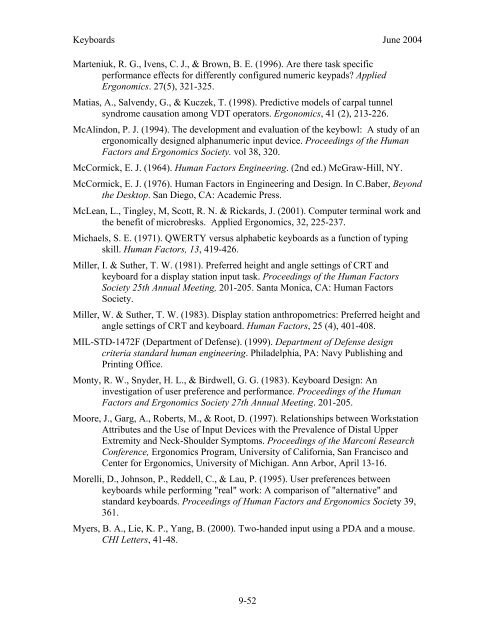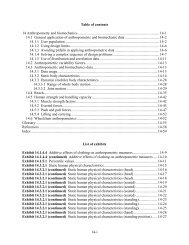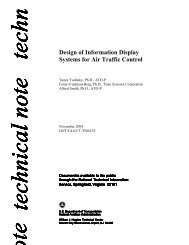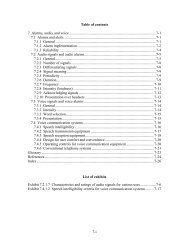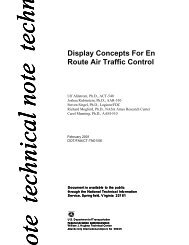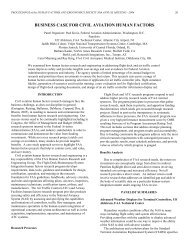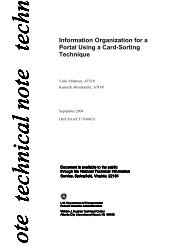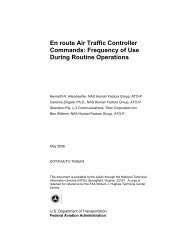Human Factors Criteria for the Design and Acquisition of ... - FAA
Human Factors Criteria for the Design and Acquisition of ... - FAA
Human Factors Criteria for the Design and Acquisition of ... - FAA
Create successful ePaper yourself
Turn your PDF publications into a flip-book with our unique Google optimized e-Paper software.
Keyboards June 2004Marteniuk, R. G., Ivens, C. J., & Brown, B. E. (1996). Are <strong>the</strong>re task specificper<strong>for</strong>mance effects <strong>for</strong> differently configured numeric keypads? AppliedErgonomics. 27(5), 321-325.Matias, A., Salvendy, G., & Kuczek, T. (1998). Predictive models <strong>of</strong> carpal tunnelsyndrome causation among VDT operators. Ergonomics, 41 (2), 213-226.McAlindon, P. J. (1994). The development <strong>and</strong> evaluation <strong>of</strong> <strong>the</strong> keybowl: A study <strong>of</strong> anergonomically designed alphanumeric input device. Proceedings <strong>of</strong> <strong>the</strong> <strong>Human</strong><strong>Factors</strong> <strong>and</strong> Ergonomics Society. vol 38, 320.McCormick, E. J. (1964). <strong>Human</strong> <strong>Factors</strong> Engineering. (2nd ed.) McGraw-Hill, NY.McCormick, E. J. (1976). <strong>Human</strong> <strong>Factors</strong> in Engineering <strong>and</strong> <strong>Design</strong>. In C.Baber, Beyond<strong>the</strong> Desktop. San Diego, CA: Academic Press.McLean, L., Tingley, M, Scott, R. N. & Rickards, J. (2001). Computer terminal work <strong>and</strong><strong>the</strong> benefit <strong>of</strong> microbresks. Applied Ergonomics, 32, 225-237.Michaels, S. E. (1971). QWERTY versus alphabetic keyboards as a function <strong>of</strong> typingskill. <strong>Human</strong> <strong>Factors</strong>, 13, 419-426.Miller, I. & Su<strong>the</strong>r, T. W. (1981). Preferred height <strong>and</strong> angle settings <strong>of</strong> CRT <strong>and</strong>keyboard <strong>for</strong> a display station input task. Proceedings <strong>of</strong> <strong>the</strong> <strong>Human</strong> <strong>Factors</strong>Society 25th Annual Meeting, 201-205. Santa Monica, CA: <strong>Human</strong> <strong>Factors</strong>Society.Miller, W. & Su<strong>the</strong>r, T. W. (1983). Display station anthropometrics: Preferred height <strong>and</strong>angle settings <strong>of</strong> CRT <strong>and</strong> keyboard. <strong>Human</strong> <strong>Factors</strong>, 25 (4), 401-408.MIL-STD-1472F (Department <strong>of</strong> Defense). (1999). Department <strong>of</strong> Defense designcriteria st<strong>and</strong>ard human engineering. Philadelphia, PA: Navy Publishing <strong>and</strong>Printing Office.Monty, R. W., Snyder, H. L., & Birdwell, G. G. (1983). Keyboard <strong>Design</strong>: Aninvestigation <strong>of</strong> user preference <strong>and</strong> per<strong>for</strong>mance. Proceedings <strong>of</strong> <strong>the</strong> <strong>Human</strong><strong>Factors</strong> <strong>and</strong> Ergonomics Society 27th Annual Meeting. 201-205.Moore, J., Garg, A., Roberts, M., & Root, D. (1997). Relationships between WorkstationAttributes <strong>and</strong> <strong>the</strong> Use <strong>of</strong> Input Devices with <strong>the</strong> Prevalence <strong>of</strong> Distal UpperExtremity <strong>and</strong> Neck-Shoulder Symptoms. Proceedings <strong>of</strong> <strong>the</strong> Marconi ResearchConference, Ergonomics Program, University <strong>of</strong> Cali<strong>for</strong>nia, San Francisco <strong>and</strong>Center <strong>for</strong> Ergonomics, University <strong>of</strong> Michigan. Ann Arbor, April 13-16.Morelli, D., Johnson, P., Reddell, C., & Lau, P. (1995). User preferences betweenkeyboards while per<strong>for</strong>ming "real" work: A comparison <strong>of</strong> "alternative" <strong>and</strong>st<strong>and</strong>ard keyboards. Proceedings <strong>of</strong> <strong>Human</strong> <strong>Factors</strong> <strong>and</strong> Ergonomics Society 39,361.Myers, B. A., Lie, K. P., Yang, B. (2000). Two-h<strong>and</strong>ed input using a PDA <strong>and</strong> a mouse.CHI Letters, 41-48.9-52


